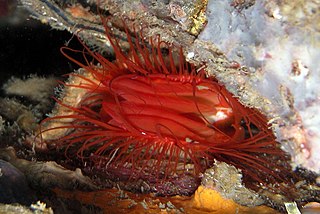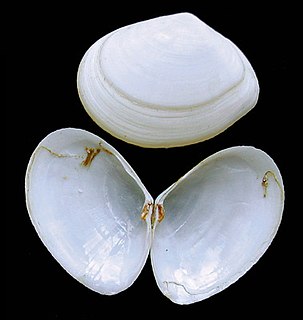
Bivalvia, in previous centuries referred to as the Lamellibranchiata and Pelecypoda, is a class of marine and freshwater molluscs that have laterally compressed bodies enclosed by a shell consisting of two hinged parts. Bivalves as a group have no head and they lack some usual molluscan organs like the radula and the odontophore. They include the clams, oysters, cockles, mussels, scallops, and numerous other families that live in saltwater, as well as a number of families that live in freshwater. The majority are filter feeders. The gills have evolved into ctenidia, specialised organs for feeding and breathing. Most bivalves bury themselves in sediment where they are relatively safe from predation. Others lie on the sea floor or attach themselves to rocks or other hard surfaces. Some bivalves, such as the scallops and file shells, can swim. The shipworms bore into wood, clay, or stone and live inside these substances.
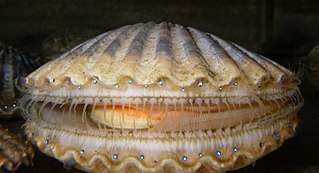
Scallop is a common name that is primarily applied to any one of numerous species of saltwater clams or marine bivalve mollusks in the taxonomic family Pectinidae, the scallops. However, the common name "scallop" is also sometimes applied to species in other closely related families within the superfamily Pectinoidea, which also includes the thorny oysters.

Tonna galea, commonly known as the giant tun, is a species of marine gastropod mollusc in the family Tonnidae. This very large sea snail or tun snail is found in the North Atlantic Ocean as far as the coast of West Africa, in the Mediterranean Sea and the Caribbean Sea. The species was first described by Carl Linnaeus in 1758.
Limatula, the file shells or file clams, is a genus of marine bivalve molluscs in the family Limidae.
Cliona californiana, the yellow boring sponge, boring sponge or sulphur sponge, is a species of demosponge belonging to the family Clionaidae. It is native to the north-eastern Pacific Ocean and burrows into the shell valves of bivalve molluscs.

Marine invertebrates are the invertebrates that live in marine habitats. Invertebrate is a blanket term that includes all animals apart from the vertebrate members of the chordate phylum. Invertebrates lack a vertebral column, and some have evolved a shell or a hard exoskeleton. As on land and in the air, marine invertebrates have a large variety of body plans, and have been categorised into over 30 phyla. They make up most of the macroscopic life in the oceans.

Atrina rigida, commonly called the rigid pen shell, is a species of bivalve mollusc in the family Pinnidae.
Polystira picta is a species of sea snail, a marine gastropod mollusk in the family Turridae, the turrids. It has been found in the shallow subtidal waters of the Gulf of Tehuantepec.
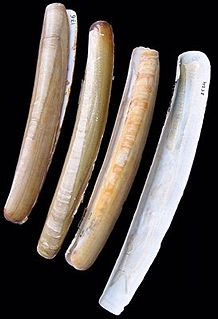
Ensis ensis, or the sword razor, is a razor clam, a marine bivalve mollusc in the family Pharidae. It lives buried in the sand and is found off the coasts of northwest Europe.
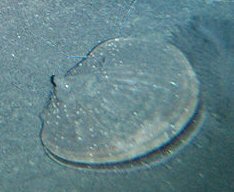
Adamussium is a monotypic genus of bivalve molluscs in the large family of scallops, the Pectinidae. The Antarctic scallop is the only species in the genus though its exact relationship to other members of the family is unclear. It is found in the ice-cold seas surrounding Antarctica, sometimes at great depths.
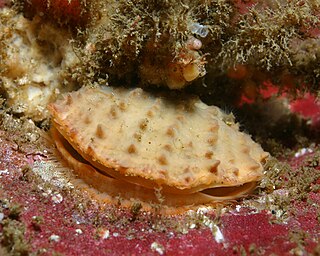
Crassadoma is a genus of rock scallops, marine bivalve molluscs in the family Pectinidae. It is monotypic, the only species being Crassadoma gigantea, the rock scallop, giant rock scallop or purple-hinge rock scallop. Although the small juveniles are free-swimming, they soon become sessile, and are cemented to the substrate. These scallops occur in the eastern Pacific Ocean.
Enigmonia is a genus of saltwater clams, a marine bivalve mollusc in the family Anomiidae, the jingle shells. Enigmonia aenigmatica, the mangrove jingle shell clam, is the only species in this monotypic genus. It is found living on mangroves in the Indo-Pacific Ocean.

Dosinia dunkeri is a species of saltwater clam, a marine bivalve mollusc in the family Veneridae.

Caryophyllia smithii, the Devonshire cup coral, is a species of solitary coral in the family Caryophylliidae. It is native to the northeastern Atlantic Ocean, the North Sea and the Mediterranean Sea. There are shallow and deep-water forms which are structurally different. It forms part of a biodiverse community of rock encrusting organisms and is often parasitised by a barnacle.
Diplasterias brucei is a species of starfish in the family Asteriidae. It is found in the Pacific Ocean and Southern Ocean. It is a predator and scavenger and is unusual among starfish in that it broods its young.
Urticinopsis antarctica is a species of sea anemone in the family Actiniidae. It is found in the Southern Ocean around Antarctica.

Terrestrial molluscs or land molluscs (mollusks) are ecological group that includes all molluscs that lives on land in contrast to freshwater and marine molluscs.
Lithophaga simplex is a species of bivalve mollusc in the family Mytilidae. It is a boring species, tunnelling into living coral colonies. It can be found in the tropical western central Pacific Ocean.
Idas simpsoni, previously known as Adipicola simpsoni, is a species of saltwater clam, a marine bivalve mollusc in the family Mytilidae, the mussels. It is a deepwater species and is only found attached to the bones of dead whales.

Anasterias antarctica, commonly called the Cinderella starfish, is a species of starfish in the family Asteriidae. It is found in coastal waters in the Southern Ocean and around Antarctica.
